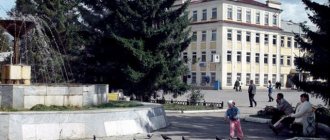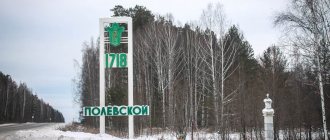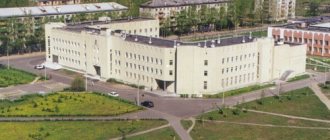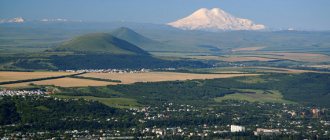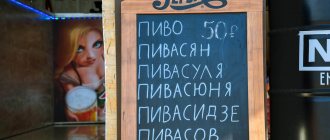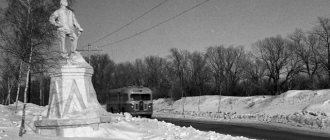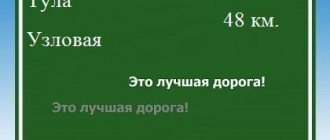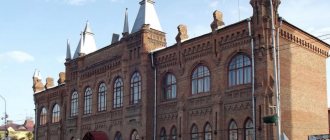A new microdistrict is being actively built, kindergartens are being built and renovated, the sphere of private kindergartens and development centers is developing, and private medicine is operating. Shopping centers and specialty stores, good transport links, consumer services.
But the economic situation leaves much to be desired, so by Order of the Government of the Russian Federation dated July 29, 2014 N 1398-r (as amended on May 13, 2016) “On approval of the list of single-industry towns”, it is included in the list of single-industry towns of the Russian Federation with the risk of worsening the socio-economic situation.
1.2. Route Novoaltaysk-Barnaul
The distance from Novoaltaisk to Barnaul in a straight line is about 12 kilometers, along the road a little further. So, it’s not unreasonable for the residents of Altaika to believe that they live practically in Barnaul, because getting to it is very convenient: there are many minibuses. Moreover, they go very often. Sometimes, getting from Novoaltaysk to Barnaul and from Barnaul to Novoaltaysk is faster than getting from one district of Barnaul to another during rush hour.
The road from Novoaltaisk to Barnaul passes next to the railway tracks, then you need to cross the Ob River along the “Old Bridge”. There are practically no traffic jams before the bridge. But during the trip you can admire the landscape outside the window.
And when you cross the Ob, you can’t help but be impressed by its power and grandeur, from the height of the bridge - it’s very beautiful!
There is a railway bridge parallel to the road bridge. Travel time by minibus from the center of Novoaltaisk to October Square in Barnaul is about 30 minutes.
Novoaltaysk on the map of Russia: nature, geographical location and climate
Geographically, Novoaltaysk is located opposite Barnaul. The cities are separated by the Ob River . Area more than 7000 hectares.
Settlements included in the urban district:
- Beloyarsk microdistrict;
- villages of Prisyagino, Novogorsky, Topolevo.
The city has business and administrative centers. Industrial is located along the railway tracks. Residential development is made up of houses ranging from 4 to 16 floors in small microdistricts. There is a private sector consisting of one-story residential buildings.
The climate in the city is sharply continental, farming is risky. The minimum temperature is -52 degrees, the maximum is +38. The annual average is 0 Celsius.
Snow begins to fall in October and begins to melt towards the end of March. The average height is 1.2 meters. About 500 mm of precipitation falls during the year. More than half occurs during the warm period.
A look at the map of Novoaltaisk from a satellite clearly demonstrates the cleanliness of the streets and the rich nature of the city. A large amount of greenery cleans the air of harmful emissions. Horticulture and livestock farming are actively developing in the private sector.
1.4. Life in Novoaltaysk
Living in the city is quite comfortable for those who are not interested in noisy, busy city life. When you find yourself here, you notice that the rhythm of life is slower and calmer. There is not a lot of traffic, as on the central roads of Barnaul, so traffic is easier here.
There is everything for a comfortable stay with children: schools, kindergartens, children's clinics, playrooms, clubs and sections.
True, the improvement is more noticeable in the new part of the city; the old part is more reminiscent of an urban-type settlement with old-built houses.
It is very comfortable to live in the area of the Labor Palace of Culture: a spacious landscaped square where city events and fairs are held; here this place is very popular with mothers and children. Nearby is a recreation park with a mini-zoo. Nearby there are two large shopping malls and a “Park”, a collection of various specialized stores. A little further away is the Asia shopping center - the residential area next to it is also quite cozy and well-maintained. If we drive even further, we find ourselves in a new microdistrict under construction.
Within the boundaries of Novoalaisk there are several gardening areas, which are conveniently accessible both by your own car and by public transport.
There is a swimming pool and a large sports complex Ob. The Palace of Culture creates a platform for versatile additional education of children and holds significant events; the Cosmos cinema performs the same functions.
The taxi service is well developed; both local and Barnaul companies operate.
History of Novoaltaisk
first aid station
After the construction of the Beloyarsk fortress in 1717 and the formation of the Beloyarsk settlement in 1724, new settlements began to appear in the surrounding areas. This was due to the large influx of population (land-poor peasants, Old Believers and others), on the one hand, and the abundance of fertile land and rich nature, on the other. In the mid-1720s, the peasant Bazhov moved with his family from the Tambov province to the Beloyarskaya Sloboda.
They were the first
The Bazhov family belonged to the so-called Old Believers: Orthodox Christians who did not share or support the church reforms of Patriarch Nikon. The Bazhovs lived for several years in the Beloyarskaya Sloboda, but due to a decline in productivity, they decided to build a farmstead behind the oxbow lake near the Chesnokovka River. Having received the permission of the clerk, in 1737, four miles from the village of Vyatkina (Chesnokovka), a new settlement appeared, which would later be named Bazhovo.
The place of settlement was chosen very well: the territory was covered with mixed forest, there were many clearings around, convenient for plowing, all kinds of fish were found in the river, hares and foxes were easy prey in winter, berries and mushrooms grew in abundance in the forest. The Bazhovs built a house, acquired livestock and a household. Other families, mostly Old Believers, settled next to them.
Later, people began to settle not only near Bazhovaya Zaimka, but also downstream of the river. Old-timers call such surnames of the first settlers as Butakovs, Pepelyaevs, Galkins. People were primarily engaged in agriculture: they plowed the land, sowed rye, wheat, flax, and oats. They also kept cows, horses, goats, sheep, poultry, and set up apiaries. The land in those places was fertile and gave good harvests, the new village grew quickly. By 1859, there were up to 52 households in Bazhovo, in which 335 people lived.
Stages of growth: from the Trans-Siberian Railway to the “Holy Cross” squad
The second mass migration of peasants to Siberia was associated with the construction of the Trans-Siberian Railway in the 1890s of the 19th century. At this time, Bazhovo, according to 1893 data, grew to 94 households and 495 inhabitants. Since most families in Bazhovo and nearby Chesnokovka adhered to the old (pre-reform) religious traditions, a community of Old Believers was created here and in 1913 a small church was built with the money of parishioners. In addition to it, there were two trading shops and three mills in the village.
By the beginning of the 20th century, the descendants of the first settlers in Bazhovo, engaged in farming, breeding and selling livestock, as well as handicraft production, were able to significantly improve their well-being. After the events of the Russian Revolution, in October 1917, power in Bazhovo, as well as throughout the country, passed into the hands of the Bolsheviks and began to be called Soviet. The majority of the peasants in the village did not understand the essence of the events taking place in Russia and Altai and were distrustful of the change in system. Prosperous people did not welcome the establishment of a new order: during the civil war, the “Holy Cross” squad was active against the Soviets in Bazhovo, Chesnokovka and Firsovo.
paramedic
Under the new government: educational program, collective farm, first-aid post
Soviet power in Siberia was finally established only in 1920. The village council becomes the authority at the local level. Without a separate building, members of the village council held meetings in private houses. Having set the task of eliminating the kulaks as a class, the authorities often confiscated property and houses from wealthy peasants in favor of the state, and simply evicted people outside the region. So, having dispossessed Vasily Petukhov, a village council was located in his house, and later it was decided to give the house of the parish priest to it. In Chesnokovka, the elderly Ulyan Vyatkin, a descendant of the founder of the village, the head of the Old Believers community of Bazhovo and Chesnokovka, was evicted from his house with confiscation of property.
All measures to strengthen Soviet power in the village were carried out by the communists. Bread and grain were forcibly confiscated from wealthy peasants, and a compulsory tax in kind was introduced, which was levied in food and cash. Then the Soviet government implemented several programs for rural reorganization: collectivization (formation of common peasant farms - collective farms), elimination of illiteracy of the population (creation of schools and compulsory education for all), development of healthcare.
As part of collectivization, the first collective farm, “For Communism,” was organized in Bazhovo in 1930, and in 1931, through the efforts of the communards, another one, “The Great Turnaround,” was created. In 1940, both collective farms were united under the common name “For Communism.” In addition to grains, the collective farm grew vegetables and potatoes and equipped a greenhouse. To eliminate illiteracy in the countryside, in 1920 a school was made from the empty Mangazeya building (a food and grain warehouse). The library opened in 1923. In 1930, at a general meeting of villagers, they decided to dismantle the church and use this forest to build a reading room in the collective farm garden.
School
The consumer cooperative store in the village was built in 1925. In the same year, as part of the GOELRO (country electrification) program, electric light was installed in the house of miller Stepanov. However, it was not until 1955 that the village was fully supplied with electricity.
Until 1930, there was no first-aid post in Bazhovo. Residents went for treatment to Chesnokovka or Beloyarsk. Then a medical (paramedic) station was opened in the house of kulak Pepelyaev, which operated for more than 30 years, only in 1964 a new building was built for it.
In 1942, when the neighboring village of Chesnokovka, in accordance with the Decree of the Presidium of the Supreme Soviet of the RSFSR, was given the status of a city, the village of Bazhovo was included in its composition. And today Bazhovo is part of the city, but it is now called not Chesnokovka, but Novoaltaysk.
Irina PUTINTSEVA,
Researcher
Novoaltaisky
local history museum
named after V.Ya. Marusina
1.5. Where to get a job in Novoaltaysk
But working here is quite difficult. There are not many key employers in Novoaltaysk, therefore, a significant part of the city's residents work in Barnaul. Although, it’s worth rephrasing - there are employers, but in the period of modern economic realities, it is very difficult to get a job at large industrial enterprises, and the level of wages leaves much to be desired.
Major employers in Novoaltaysk include:
- Maria-Ra trading networks, a large logistics center (warehouse) Maria-Ra is located here;
- chains Anix, Holiday, the Magnit hypermarket has recently opened;
- Euroset, Megafon, MTS;
- networks of microfinance organizations are thriving, and there are branches of several banks;
- Specialists in the field can get a job in the police department, medical institutions, they are always waiting for new employees in the educational sector - kindergartens, schools;
- the large Altaiskaya railway station and other divisions of Russian Railways provide jobs for many residents of Novoaltaisk, although it is now very difficult to get a job there, especially without a specialized education;
- Of the manufacturing enterprises, it is worth noting Altaykhleb (production of bakery products), Svit (sewing enterprise)
- in industry, we can note OJSC Altaivagon, NZZhBI (Novoaltaisky Plant of Reinforced Concrete Products named after G.S. Ivanov), CJSC Altaikrovlya, OJSC Beloyarsk Mast Impregnation Plant. True, lately we have hardly heard any positive reviews about working there. Look for details yourself.
- Also worth noting is the large enterprise Alterra, the Solnechny Park Hotel, and several large shopping and entertainment centers.
- Russian Post and Sibirtelecom can also be considered potential employers.
Biysk is the cultural center of the Altai Territory
Biysk is a city of regional significance. An important scientific and industrial center of the entire Southern Siberia, as well as a cultural and educational center of the region, is located here. In terms of population, Biysk is in second place. It is located on the Biya River, in the southeast of the Altai Territory. More than 200,000 people live here, and the population is constantly growing. People come here from villages and towns, people consider Biysk calm and promising, get a job, and later stay. There are many people who go to work in large urban areas in Russia and abroad.
The economy is based on local enterprises that employ city residents. Marketers, engineers, and technologists are valued here, and the salaries of good specialists are decent. It is more difficult for women to get a job; they mostly work in the trade sector. Things are going well with education, there are several universities in Biysk, there are colleges, including medical and polytechnic, there are technical schools and gymnasiums.
The local ecology cannot be called good; this is a significant disadvantage for the local population. The timber mill located in Biysk and local residents pollute the rivers. Swimming in local waters is prohibited.
1.8. Population of Novoaltaisk
According to statistics, the population of Novoaltaisk has been increasing since 2013. So, in 2013, 70,357 people lived here, and according to 2021 data, 73,134 people live in Novoaltaysk. Perhaps this can be associated with the construction of new buildings, the cost of housing in which is an order of magnitude lower than in Barnaul, and with an increase in the birth rate.
In preparing the material, information from the website ru.wikipedia.org and information provided by interviewed city residents was used. © ecoaltai.rf
If you have something to say about Novoaltaisk, please mark it in the comments, you will be grateful to hundreds of users who are looking for reviews about Novoaltaisk and reviews about life in Novoaltaisk.
Rubtsovsk is a former mechanical engineering center
Among the Altai steppes, on the left bank of the Alei River stands Rubtsovsk. It used to be a major mechanical engineering center, before the collapse of the USSR. It is the administrative center of the Rubtsovsky district, which it is not part of. The name of the city was given in honor of the peasant Mikhail Rubtsov, who was a migrant. Until 1991, the local population grew, but then gradually began to decline, a problem that continues here to this day. Gradually, by 2009, natural population growth began to increase. The number of inhabitants is decreasing, but not as much as before.
The main reasons why people leave are the lack of jobs and low wages, although specialists are always welcome at enterprises and they can receive decent pay for good, qualified work. Local residents of Rubtsovsk work at local factories, industrial enterprises, and in trade. Since 2009, there has been an increase in migrants from villages and small towns. People come to get a job and study. Many remain permanently. The number of marriages has increased and there are fewer divorces, which is also very encouraging.
